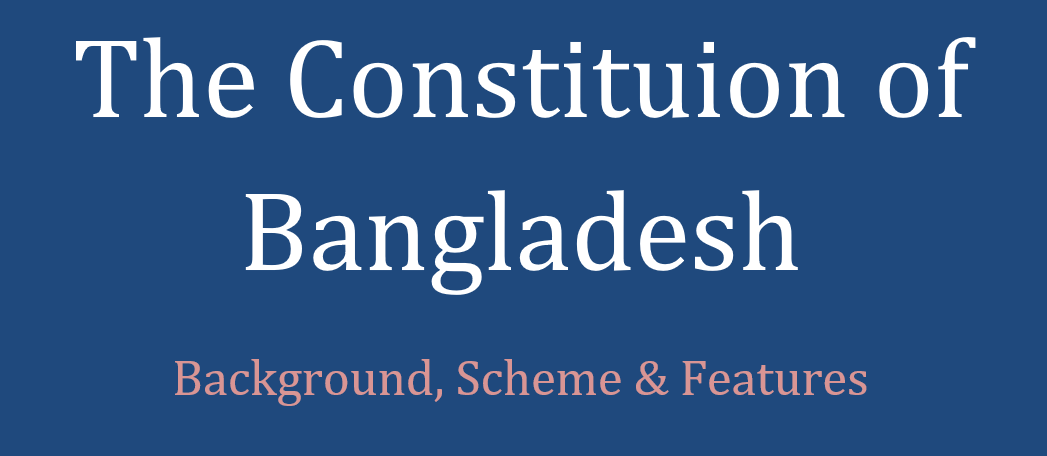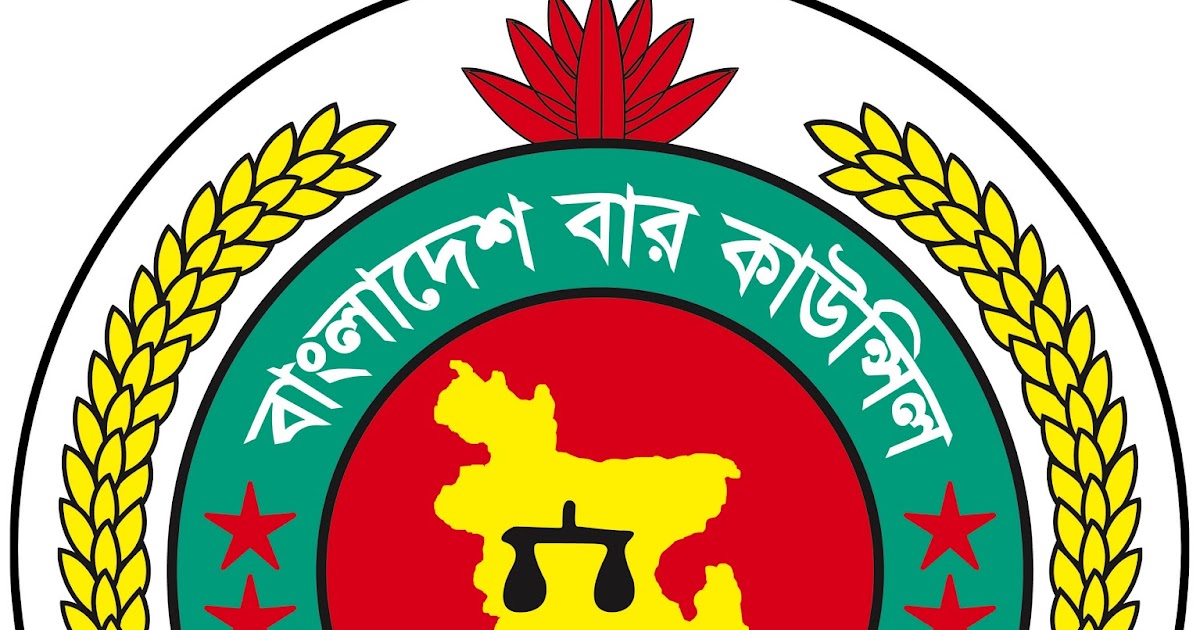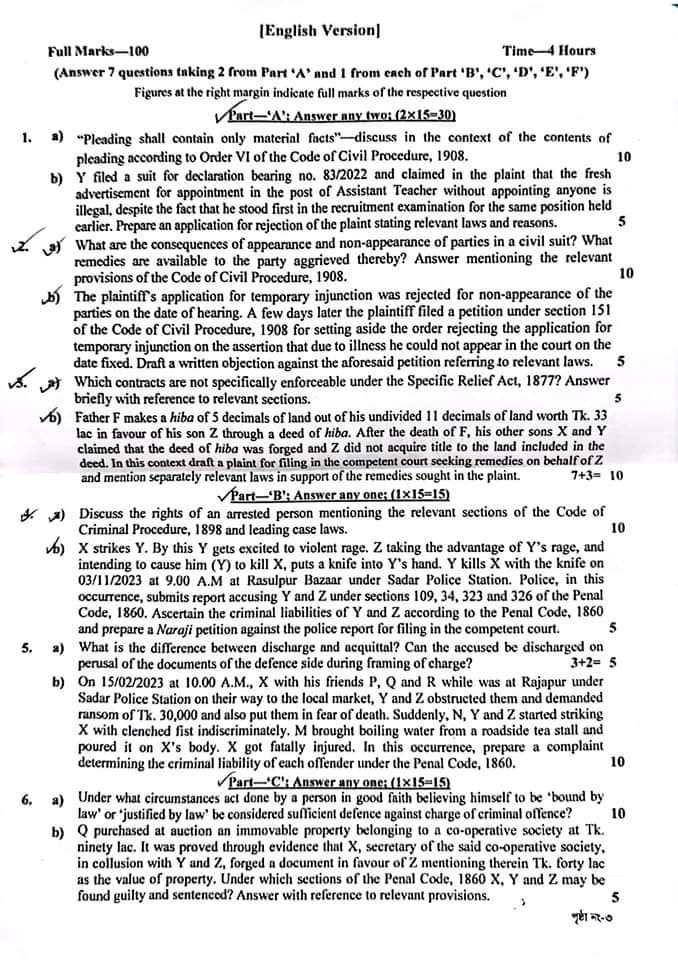Background, scheme and features of the Constitution of Bangladesh
Background:
Bangladesh emerged as an independent state on December 16, 1971, after having witnessed one of the most brutal blood-baths in modern history. It adopted the constitution on November 4, 1972, only 325 days after her liberation. Besides, there had been few instruments which worked as interim constitutions and did authorize and help the government to run the state until a new constitution is introduced. These instruments are going to be discussed hereinafter.
The Proclamation of Independence:
Proclamation of Independence is considered to be the first constitution of Bangladesh. During the continuance of Liberation War, on April 10, 1971, this vital instrument was written, drafted and declared by interim government of Bangladesh popularly known as Mujibnagar Government giving retrospective effect from March 26, 1971. The main features of the Proclamation of Independence include –
1. the Proclamation of Independence formed the presidential system of government and provided for “Sheikh Mujibur Rahman” shall be the President of the Republic. However, the president was given all the powers including legislative and executive authority by this interim constitution. It provides,
“The President shall be the Supreme Commander of the Republic, shall exercise all the Executive and Legislative powers of the Republic including the power to grant the pardon.”
2. The president was also given the authority to appoint a prime minister and such other ministers as he considers necessary, levy taxes and expend monies, summon and adjourn the constituent assembly and do all other things that may be necessary to give the people of Bangladesh an orderly and just government.
3. If there is president, or president unable to perform his duty for any reason whatsoever, the vice-president shall exercise all the powers, duties and responsibilities conferred on the president. The proclamation also abided by the rules of the Charter of the United Nations.
The Laws Continuance Enforcement
Order 1971:
Meanwhile,
the Laws Continuance Enforcement Order 1971 was passed by the acting president
on April 10, 1971 and provided that-
“all laws that were in force in Bangladesh on 25th march, 1971, shall subject to the Proclamation aforesaid continue to be so in force with such consequential changes as may be necessary on account of the creation of the sovereign independent state of Bangladesh formed by the will of the people of Bangladesh.”
The Provisional Constitution of Bangladesh order, 1972:
The president Bangabandhu Sheikh Mujibur Rahman declared “The Provisional Constitution of Bangladesh order, 1972‟ on the next day after his arrival in Bangladesh on January 10 1972. This order introduced parliamentary form of government system instead of presidential form of government system. Main features of the Provisional Constitution of Bangladesh order, 1972 are as follows-
1. "Whereas, it is the manifest aspiration of the people of Bangladesh that a parliamentary democracy shall function in Bangladesh" (Preamble)
2. The order provided that: "there shall be a cabinet of ministers with the Prime Minister at the head" (Art. 5);
3. "The President shall, in exercise of his functions, act in accordance with the advice of the Prime Minister" (Arts. 6);
4. "The President shall commission as Prime Minister a member of the Constituent Assembly, who commands the confidence of the members of the Constituent Assembly" (Art. 7); and all ministers shall be appointed by the President "on the advice of the Prime Minister" (Art. 7).
5. The new Order altered the fundamentals of the interim government introduced parliamentary system of government in independent Bangladesh. The next day Sheikh Mujib resigned from the presidency and took over as the Prime Minister of Bangladesh. Justice Abu Sayeed Choudhury, became the new president of the Republic.
Bangladesh Constituent Assembly Order (Presidential Order. No. 22), 1972:
The first step to frame a constitution was the promulgation of "Bangladesh Constituent Assembly Order" (P.O. No. 22) which constituted the Constituent Assembly. The Assembly comprised the members who had been elected from Bangladesh to the then Pakistan National Assembly and the East Pakistan Provincial Assembly in the elections held in 1970 and I97I. Accordingly, 403 Members formed the Constituent Assembly. Making of the Constitution was one of the manifests of the Constituent Assembly. The first meeting of the Constituent Assembly was held on April 10, 1972. In this session, a Constitution Drafting Committee consisting of 34 members was formed under the Chairmanship of Dr. Kamal Hossain, the then Law Minister. The only woman member of the Constitution Drafting Committee was Razia Banu, whereas the only opposition member was Mr. Surenjit Sen Gupta. The Draft Constitution of 72 pages containing 103 Articles was presented to the Constituent Assembly on October 12, 1972, in its second session. On this day, Dr. Kamal Hossain introduced the Draft Constitution as a Bill. On November 4, 1972. After long discussion and several amendments, the Assembly passed the Constitution of Bangladesh on November 4, 1972 giving the effect from December 16, 1972, on the first anniversary of the victory day of Bangladesh.
Chronological Stages of Adoption of the Constitution:
a) The Proclamation of Independence; April, 10 1971
b) Oath of Mujibnagar Govt; April 17, 1971
c) The Laws Continuance Enforcement Order 1971
d) The Provisional Constitution of Bangladesh Order; January 11, 1972
e) The Constituent Assembly Order; March 22, 1972
f) 1 st Session of Assembly; April 10 & 11, 1972
g) 1 st Session of Committee, April 17, 1972
h) Introduction of the Bill to the Assembly; October 12, 1972
i) The Bill was passed by the Assembly; November 4, 1972
j) Enforcement of the Constitution; December 16, 1972
Scheme and Features:
The constitution of Bangladesh provides the framework of the Republic of Bangladesh having features of parliamentary government, fundamental human rights and freedoms, an independent judiciary, democratic local government and a national bureaucracy. The fundamental principles of this constitution are socialism, secular democracy and the Bengali nationalism. Among others, the following features of the constitution of Bangladesh are worth mentioning:
Written Cobstitution:
The constitution is a written document and is divided into 11 parts, which are further subdivided into 153 articles. In addition to these articles, there are 7 schedules in the constitution of Bangladesh.
Rigid Constitution:
Constitution of Bangladesh is a rigid or inflexible one. It cannot be amended in ordinary law-making process. For example, votes of two-third members in the total members of parliament are needed to pass a bill to amend the constitution.
Preamble:
This is the opening statement that sets out the guiding purpose and principles of the constitution. The constitution of Bangladesh contains preamble which are regarded as an integral part of it. Though, this preamble is not enforceable in a court of law, it is one of the basic structures which cannot be amended.
Fundamental Principle of State Policy:
Part II of the Constitution of Bangladesh contains the fundamental principles of state policy and article 8 of the constitution contains the fundamental principles of the constitution which are Nationalism, Democracy, Socialism and Secularism.
Fundamental Right:
The third part of the constitution of Bangladesh describes the fundamental rights and ensures their enforcement. Article 26 provides that any law inconsistent with this part has to be declared as void. Among others these fundamental rights include equality before law, right to protection of law, prohibition of forced labor, freedom of movement, freedom of assembly etc.
Independence of the Judiciary:
Judicial independence is the theory that the judiciary should be separated from other organs of the state i.e., the executive and the legislature. Article 22 requires the state to separate the judiciary from executive part. Again, other provisions of the constitution i.e., article 94(4) and article 116A of the provides for the justices of the supreme court of Bangladesh as well as the judges of subordinate courts shall be independent in exercising their powers and carrying out their functions.
Unicameral Legislature:
According to Article 65 of Bangladesh constitution, the parliament of Bangladesh i.e., the House of Nation is a unicameral one. That means there is only one house of parliament commonly known as 'Jatiya Sangshad'.
Unitary Government:
Bangladeshi government is unitary
according to article 1 of the constitution which inter alia provides
that:
“Bangladesh is a unitary, independent, sovereign Republic to be known as the People's Republic of Bangladesh.”
Parliamentary form of government:
According to the constitution, the Parliament
of Bangladesh is a Westminster type of parliament. Here, the government is run
by cabinet lead by the prime minister. The president is head of the state but
executive power is exercised by the cabinet of ministers.






